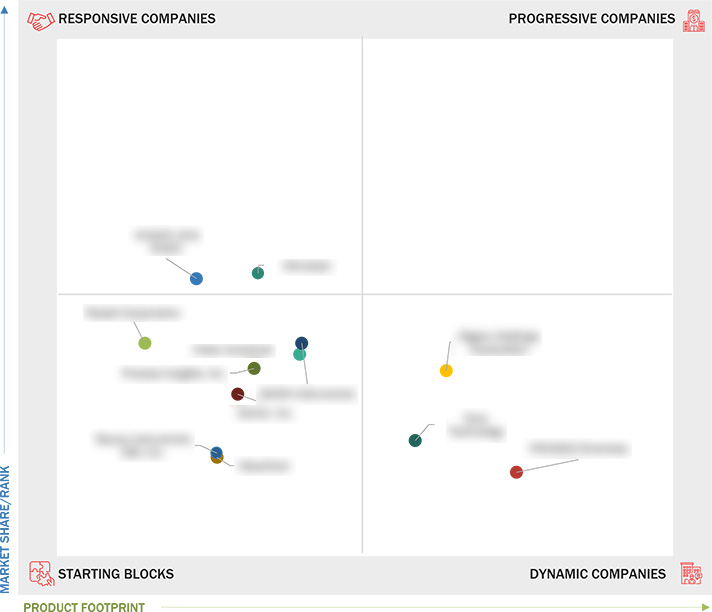Comparing 12 vendors in Environmental Testing Products Startups across 0 criteria.
The environmental testing products market encompasses various analytical technologies that are utilized in lab settings to identify or assess pollutants in a given sample. These products include spectroscopy and chromatography systems, PCR and immunoassay, and portable testing devices used across industries such as wastewater treatment , food safety, industrial manufacturing, and regulatory compliance.
Market Leadership Quadrant
1.1 Study Objectives
1.2 Market Definition
1.3 Study Scope
1.3.1 Markets Covered and Regional Scope
1.3.2 Inclusions and Exclusions
1.3.3 Years Considered
1.4 Currency Considered
1.5 Unit Considered
1.6 Limitations
1.7 Stakeholders
2.1 Introduction
2.2 Market Dynamics
2.2.1 Drivers
2.2.1.1 Rising technological innovations in environmental testing
2.2.1.2 Growing public awareness related to health impact of pollution
2.2.1.3 Development of portable and real-time environmental monitoring technologies
2.2.1.4 Increased participation of government and regulatory bodies in monitoring environmental conditions
2.2.2 Restraints
2.2.2.1 Expensive consumables and high maintenance cost of mass spectrometry instruments
2.2.2.2 Technological limitations in mass spectrometry
2.2.3 Opportunities
2.2.3.1 Increasing government focus on contaminant detection
2.2.3.2 Increased utilization of AI-driven analytical tools to detect air and soil pollution
2.2.3.3 Advancements in environmental testing infrastructure
2.2.4 Challenges
2.2.4.1 Increased operational complexity of mass spectrometry products
2.2.4.2 Lack of skilled professionals
2.3 Trends/Disruptions Impacting Customer Business
2.4 Value Chain Analysis
2.5 Ecosystem Analysis
2.6 Investment and Funding Scenario
2.7 Technology Analysis
2.7.1 Key Technologies
2.7.2 Complementary Technologies
2.7.3 Adjacent Technologies
2.8 Patent Analysis
2.9 Trade Analysis
2.10 Porter’s Five Forces Analysis
2.10.1 Threat of New Entrants
2.10.2 Threat of Substitutes
2.10.3 Bargaining Power of Suppliers
2.10.4 Bargaining Power of Buyers
2.10.5 Intensity of Competitive Rivalry
3.1 Introduction
3.2 Key Player Strategies/Right to Win
3.3 Revenue Analysis
3.4 Market Share Analysis
3.5 Company Valuation and Financial Metrics
3.6 Brand/Product Comparison
3.7 Company Evaluation Matrix: Startups/SMEs
3.7.1 Progressive Companies
3.7.2 Responsive Companies
3.7.3 Dynamic Companies
3.7.4 Starting Blocks
3.7.5 Competitive Benchmarking: Startups/SMEs
3.7.5.1 Detailed list of key startups/SMEs
3.7.5.2 Competitive benchmarking of key startups/SMEs
3.8 Competitive Scenario
3.8.1 Product Launches
3.8.2 Deals
3.8.3 Expansions
4.1 Advion , Inc.
4.1.1 Business overview
4.1.2 Products/Solutions/Services offered
4.1.3 Recent developments
4.2 Analytik Jena GmbH+Co. KG
4.2.1 Business overview
4.2.2 Products/Solutions/Services offered
4.2.3 Recent developments
4.3 Hiden Analytical
4.3.1 Business overview
4.3.2 Products/Solutions/Services offered
4.3.3 Recent developments
4.4 Kore Technology
4.4.1 Business overview
4.4.2 Products/Solutions/Services offered
4.4.3 Recent developments
4.5 MassTech
4.5.1 Business overview
4.5.2 Products/Solutions/Services offered
4.5.3 Recent developments
4.6 Microsaic
4.6.1 Business overview
4.6.2 Products/Solutions/Services offered
4.6.3 Recent developments
4.7 Process Insights, Inc.
4.7.1 Business overview
4.7.2 Products/Solutions/Services offered
4.7.3 Recent developments
4.8 Restek Corporation
4.8.1 Business overview
4.8.2 Products/Solutions/Services offered
4.8.3 Recent developments
4.9 Rigaku Holdings Corporation
4.9.1 Business overview
4.9.2 Products/Solutions/Services offered
4.9.3 Recent developments
4.10 SCION Instruments
4.10.1 Business overview
4.10.2 Products/Solutions/Services offered
4.10.3 Recent developments
4.11 Skyray Instruments USA, Inc.
4.11.1 Business overview
4.11.2 Products/Solutions/Services offered
4.11.3 Recent developments
4.12 YOUNGIN Chromass
4.12.1 Business overview
4.12.2 Products/Solutions/Services offered
4.12.3 Recent developments


 azom
azom
 Apr 2025
Apr 2025

